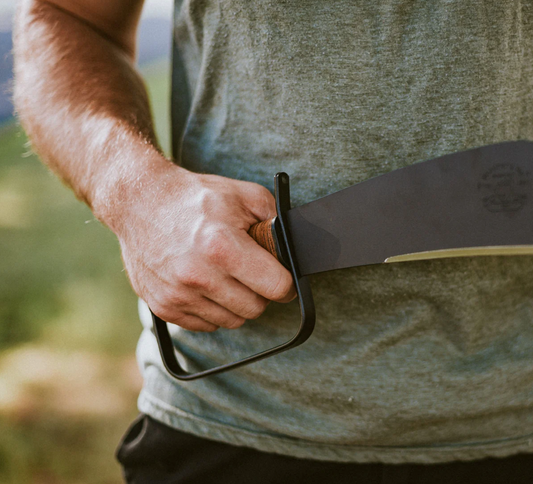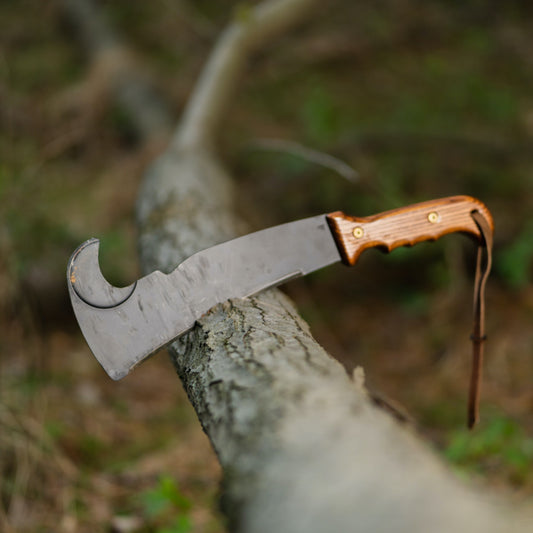Do your blades feel dull and ineffective?
Whether you’re sharpening your trusty Woodman’s Pal machete or restoring a favorite hunting knife, mastering the sharpening stone is an essential skill for any blade owner.
In this guide, we’ll walk you through everything you need to know to sharpen like a pro, including the tools you’ll need, step-by-step techniques, and tips for specific blades.
What is a Sharpening Stone?
A sharpening stone is a time-tested tool designed to restore a blade’s edge by grinding away imperfections.
These stones come in various shapes, sizes, and materials but all share one goal: to create a sharp edge.
How Does a Sharpening Stone Work?
Sharpening stones use friction to remove material from the blade’s edge.
By carefully abrading the metal, the stone reshapes and refines the blade, making it sharp enough to slice through tough materials with ease.
Applications of Sharpening Stones
Sharpening stones are versatile tools that work on:
- Hunting and fishing knives
- Axes and hatchets
- Machetes (like the Woodman’s Pal)
- Kitchen knives and scissors
Why Choose a Sharpening Stone?
Unlike pull-through sharpeners or electric systems, sharpening stones give you complete control.
You can address specific problem areas, repair chips, and maintain various blade angles depending on your tool’s purpose.Plus, these accessories provide a tactile, hands-on experience that many enthusiasts find rewarding.
Types of Sharpening Stones (Natural vs. Synthetic)
When shopping for a sharpening stone, you’ll notice that there are two types commonly offered:
- Natural Stones: Harvested from quarries, these stones offer organic grit and a smooth finish.
- Synthetic Stones: Manufactured for consistency, they’re often more affordable and available in a wider range of grit sizes.
Step-by-Step Guide to Sharpening with a Stone
Once you’ve selected a sharpening stone for your needs, you should take the time to learn how to properly use this accessory:
Prep the Stone
Before sharpening your Woodman’s Pal or other bladed tool, soak the stone in water for 15–20 minutes or apply oil to its surface, depending on the stone type.
Set the Angle
Determine the ideal blade angle. For a machete, angles between 20–35 degrees are common. A sharpening guide can help ensure consistency.
Hone Your Sharpening Technique
- Place the blade at the desired angle against the stone.
- Use steady, even strokes, moving the blade from the base to the tip.
- Flip the blade and repeat on the other side.
- Alternate sides every few strokes to maintain balance.
Clean and Store the Stone When Not In Use
Rinse the stone thoroughly after use to remove metal shavings. Store it in a dry place to prevent damage.
How To Sharpen a Machete with a Sharpening Stone
Keeping your machete sharp isn’t just about performance—it’s about safety and efficiency too.
A well-sharpened blade cuts cleaner, reduces effort, and minimizes the risk of accidents.
Using a sharpening stone is one of the best ways to maintain your machete’s edge, and it gives you the control needed to customize the blade angle for different tasks.
Let’s break down the process step-by-step to help you sharpen like a pro.
Blade Angles for Different Uses
For cutting grass, aim for 20–25 degrees. For tougher tasks like chopping wood, go for 25–35 degrees for added durability.
Tips for Effective Machete Sharpening
To avoid damaging your tool, be sure to follow these tips:
- Use light pressure to avoid over-grinding.
- Lubricate the stone to reduce friction and extend its lifespan.
- Don’t rush the process; uneven strokes lead to uneven edges.
- Avoid using the wrong grit for the job, as this can damage the blade.
Every Woodman’s Pal Comes with a Sharpening Stone
Every Woodman’s Pal machete comes with a high-quality sharpening stone because we know the value of maintenance.
Our stones are carefully chosen to complement the precision-crafted blades of the Woodman’s Pal.
Sharpen Your Skills and Your Blades with the Woodman’s Pal
Ready to sharpen your skills?
Using a sharpening stone is not just about keeping your blades effective—it’s about honoring the tools you rely on. With your new knowledge, you’re prepared to tackle any dull blade with confidence.
Order your Woodman’s Pal, and get a dual-grit sharpening stone included to master the art of sharpening!
If you already own a Woodman’s Pal, you can order a new, replacement sharpening stone if your original has served its purpose.
Don’t wait—start restoring your blades to their peak performance now!


